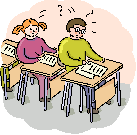| |
By the end of this lesson you should be able to:
- identify a number of development indicators (education indicators like rates of literacy, number of teachers, school equipment, etc)
- categorise a number of facts which divide rich and poor countries
- make decisions about countries based upon these facts
 Education is a very important part of people’s lives. In Catalonia and Scotland, for example, the Government thinks it is important to educate children free of charge. Being able to read and write is important because without education people cannot do many things in life, especially find a good job. Education is a very important part of people’s lives. In Catalonia and Scotland, for example, the Government thinks it is important to educate children free of charge. Being able to read and write is important because without education people cannot do many things in life, especially find a good job.
In most developing countries parents must pay to send their children to school. Many people cannot afford to do this and this means that the majority of people are unable to read or write. Even when children in the developing world attend school, their schools are poorly equipped and there is usually a shortage of teachers. As a result, many developing countries have low rates of literacy.
EXERCISE 1
Answer the following questions using your own words:
- Why are children in Catalonia and Scotland so lucky when it comes to education?
- Why is it important to be able to read and write?
- Why are many children in the developing south unable to read and write?
EXERCISE 2
Use the information in the table below to complete the bar graph showing LITERACY LEVELS in three countries.
Country |
Literacy Levels
Percentage of people who can read and write. |
United Kingdom |
99% |
Sudan |
27% |
Rwanda |
59% |
TITLE: Literacy Levels
|





